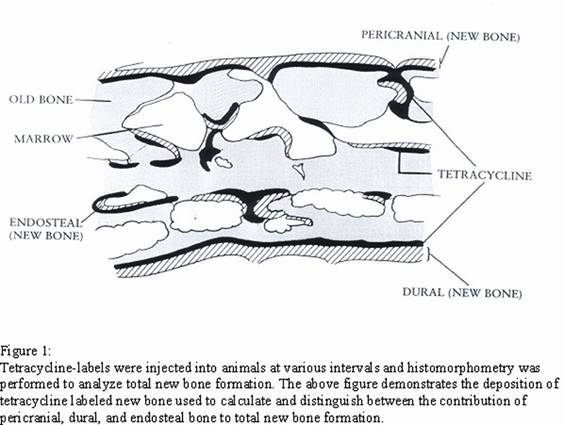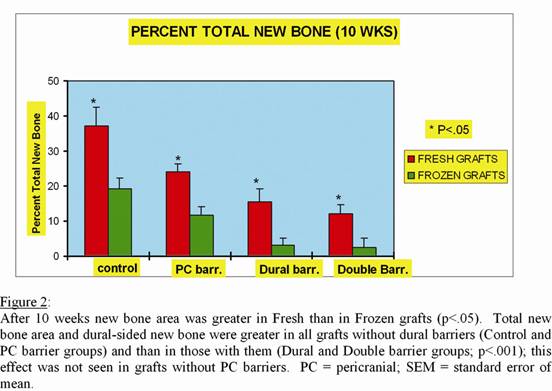Saturday, October 2, 2010
18069
What Makes the Calvaria a Privileged Site for Bone Graft Survival?
Whereas the dura and pericranium (PC) have been shown to contribute to osteogenesis in cranial defects, their role in maintaining bone graft viability is less clear. The present study was performed to isolate the role of the dura and the PC in the survival of both fresh (osteoblasts viable) and frozen (osteoblasts non-viable) bone graft.
Methods: Bilateral craniectomies were performed in 48 mature rabbits. On one side the bone was replaced immediately; on the contralateral side it was flash frozen before replacement. Animals were randomized into 4 groups by placement of silastic barriers adjacent to the bone grafts: 1) Control (no barriers); 2) Dural barrier; 3) PC barrier; 4) Double (dural and PC) barriers. Fluorescein labels were injected at specified intervals, and animals were sacrificed after either 1 or 10 weeks (Figure1). Bone grafts were analyzed with histomorphometry.
Results: After 1week fresh grafts without dural barriers demonstrated greater fluorescein-labeling on the dural than on the PC surface (p<.05); there was NSD on the PC surface of grafts without PC barriers. After 10 weeks new bone area was greater in Fresh than in Frozen grafts (p<.05, Figure 2). Total new bone area and dural-sided new bone were greater in all grafts without dural barriers than in those with them (p<.001); this effect was not seen in grafts without PC barriers. PC-sided new bone was greater in Fresh grafts without a PC barrier than in those with them (p<.001); this effect was not seen in Frozen grafts.
Conclusion: Fresh grafts containing viable osteoblasts demonstrate enhanced osteogenesis irrespective of adjacent tissues. Contact with both the dura and the pericranium contributed to osteogenesis within the grafts, though contact with the dura was far more effective. Dural contact enhanced osteogenesis through the entire graft irrespective of the presence of viable osteoblasts (fresh vs. frozen grafts), while contact with the pericranium enhanced osteogenesis only on the pericranial surface of fresh grafts. These data indicate that the dura is largely responsible for rendering the calvarium a privileged site for extended bone grafts. 

